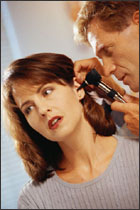Noise, or unwanted sound, is one of the most common health problems in American workplaces. The National Institute for
Occupational Safety and Health (NIOSH) estimates that 30 million workers in the U.S. are exposed to hazardous noise. Exposure to high levels
of noise may cause hearing loss, create physical and psychological stress, reduce productivity, interfere with communication, and contribute
to accidents and injuries by making it difficult to hear warning signals.
OSHA requires employers to determine if workers are exposed to excessive noise in the workplace. If so, the employers must implement feasible
engineering or administrative controls to eliminate or reduce hazardous levels of noise. Where controls are not sufficient, employers must
implement an effective hearing conservation program.
|

 |
| This eTool is a chapter of the OSHA Technical Manual
developed to assist OSHA staff in evaluating workplace hazards. eTools are "stand-alone," interactive, Web-based training tools on
occupational safety and health topics. As indicated in the disclaimer, this eTool is not an
OSHA standard or regulation, and it creates no legal obligations. Likewise, the eTool does not eliminate or limit any obligations that may be
created by the OSH Act or by OSHA standards or regulations. Employers in States with OSHA-approved State plans should contact the State for
specific information on State requirements which may differed from Federal requirements. A list of States with OSHA plans and contact
information may be found on the OSHA website.
|
|
|

